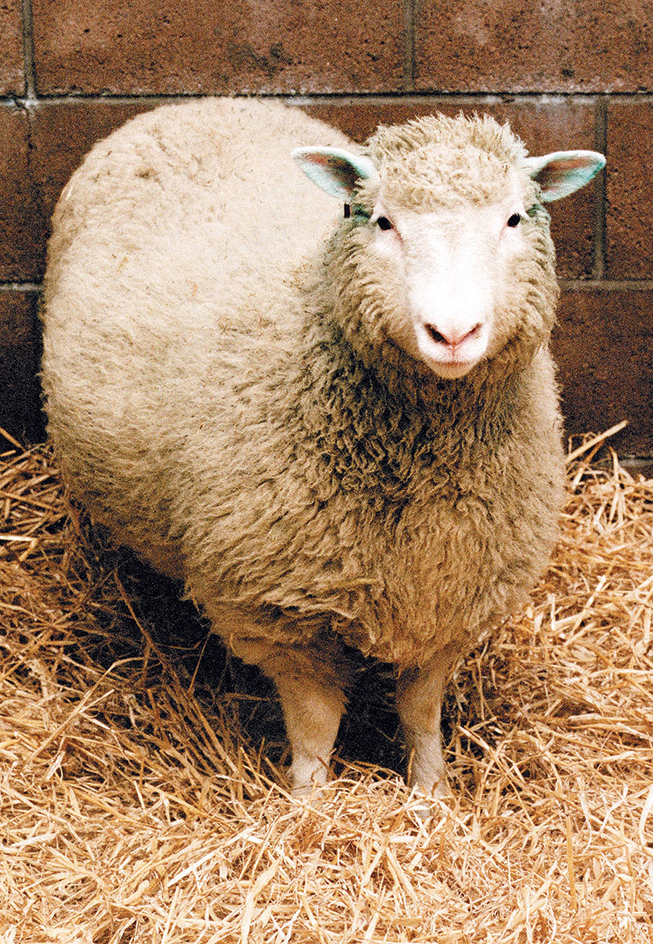Wilmut, Ian (1944-2023), was the British scientist who led the team that created Dolly, the sheep whose 1996 birth was hailed throughout the world as a milestone in cloning. Cloning is using laboratory methods to create animals or groups of cells that have exactly the same genes (hereditary instructions). Dolly was the first mammal cloned from an adult cell of another animal, a feat many scientists thought impossible before Wilmut succeeded.
Early life.
Ian Wilmut was born on July 7, 1944, in Hampton Lucy, England, near Coventry. He earned an undergraduate degree in agricultural science at the University of Nottingham. In 1971, he received a doctoral degree in embryology from Cambridge University. Embryology << ehm bree OL uh jee >> is the science of the events and processes involved in the earliest stages of life before birth.
Just after completing his doctorate, Wilmut produced the first calf—named Frosty—ever born from a frozen embryo (early stage of life before birth). Following that achievement, he joined the staff of the Animal Breeding Research Station in Roslin, Scotland, a few miles south of Edinburgh. In 1993, the Animal Breeding Research Station became the Roslin Institute. The institute, where Wilmut’s team created Dolly, is a nonprofit organization dedicated to understanding and improving the productivity, breeding, and welfare of farm animals.
The cloning of Dolly.
Successful cloning experiments before Dolly had used cells from an extremely early stage of development consisting of only a few similar-looking cells. As an animal develops from a fertilized egg, cells begin to specialize as blood, bone, skin, and all the other kinds of cells in the body. This specialization occurs because different genes become active or inactive. Most scientists assumed that the inactive genes in specialized cells could no longer direct the development of a complete animal.

Wilmut and his team of scientists reasoned that depriving an adult cell of food might force it into a kind of hibernation. They could then transfer its genes into another cell and stimulate that cell to begin dividing. They hoped that this stimulation would reactivate all the transferred genes, including those that had become inactive.
Wilmut’s team used this technique in the experiment that created Dolly. They removed the nucleus, which contains the genes, from a female sheep’s egg cell. The scientists then replaced the nucleus with a “hibernating” nucleus from another adult female sheep. This transfer made the egg cell genetically identical to the adult sheep who contributed the replacement nucleus. After stimulating the egg with an electrical charge, the scientists placed it in the womb of a third female sheep. The egg developed normally, and Dolly was born in 1996. Wilmut’s team announced her birth early in 1997. Dolly was put to death in 2003, suffering from a viral lung disease, after she had lived about half the normal life expectancy of her breed. Scientists doubt that Dolly’s early death was related to the fact that she was a clone.
Before they produced Dolly, Wilmut’s team tried this technique about 275 times without success. Since Dolly’s birth, other scientists have used a similar method to clone other mammals, including cows and mice. The ability to clone adults is important because it enables scientists to duplicate animals who have demonstrated desirable qualities. Such qualities might include producing exceptional meat or milk or resisting disease.
Later life.
In 2005, Wilmut moved to the University of Edinburgh. In 2006, he became the director of the university’s Centre for Regenerative Medicine. Wilmut was made a knight in 2008 in recognition of his contributions to science, becoming Sir Ian Wilmut. He died on Sept. 10, 2023.
